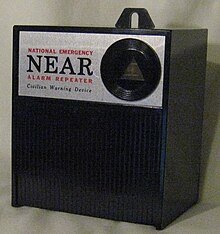The National Emergency Alarm Repeater (NEAR) was a civilian emergency warning device in the United States. It was a 2–3" (5–7.5 cm) square box designed to plug into a standard power outlet to receive a special signal sent over the electric power transmission lines. Research and testing for the NEAR program was developed in 1956 during the Cold War to supplement the existing siren warning systems and radio broadcasts in the event of a nuclear attack. The advent of the radio Emergency Broadcast System rendered NEAR obsolete, although a severe disadvantage inherent in the Emergency Broadcast System was that it required a television or radio to be turned on for a household to receive the emergency alarm, whereas NEAR did not. Despite this advantage, upon the introduction of the Emergency Broadcast System, stockpiled NEAR repeaters were destroyed by their respective manufacturers.[1]

A similar program was proposed in the United Kingdom during the 1960s.[citation needed]
Time magazine article edit
A Time magazine article in the 14 November 1960 issue[2] outlined a new program supplementing the then "basically unsound" warning system consisting of localized sirens and the CONELRAD radio-alert system.
The United States Army argued that in the age of intercontinental ballistic missiles a civil-defense warning system should be capable of warning 90% of the population within 30 seconds after a signal is given by the national civil-defense center in Colorado Springs.
The device is a buzzer installed into ordinary electrical outlets. The devices would be set off in an emergency by altering the regular AC signal being generated and transmitted by the local power companies. This would be done by having a specific alternating current of a specific frequency superimposed upon it; the imposed current would be generated by special generators and would be at 270 Hz at 3 volts RMS for 50,000 cycles (U.S. patent 3,284,791),[3] approximately three minutes.
The indoor buzzers would be supplemented with outdoor warning sirens.[2]
An episode of the PBS television program History Detectives[1] suggested that problems with NEAR might have included limited instructions on what to do when an alert was received and the device's inability to provide information on what exactly was happening. EMP effects of a high-altitude nuclear detonation could have disabled the system. After a decade of federal support for testing and development, the program was terminated.[1]
See also edit
References edit
- ^ a b c "Investigations: N.E.A.R Device". History Detectives. Season 7. Episode 8. August 2009. PBS. Episode 709, Story 3: N.E.A.R Device (PDF).
- ^ a b "CIVIL DEFENSE: Buzzers Mean Bombs". TIME. 14 November 1960. Archived from the original on 5 December 2007. Retrieved 19 May 2010.
- ^ US application 3284791, VOIGT, Robert H. & OSBORNE, Jack D., "Near alarm receiver having-time delay of discharge type", published 8 November 1966. Page 3, lines 32-43
External links edit
- "Status of NEAR program still cloudy to utilities". Electrical World. 18 December 1961.
- Green III, Walter G., ed. (25 November 2004). "National Emergency Alarm Repeater (NEAR) System". The Electronic Encyclopaedia of Civil Defense and Emergency Management, University of Richmond. Archived from the original on 17 May 2008.
- "Sect. III: Warning Systems, Federal Warning Systems". Office of Civil Defense Program: 1966 Summary (PDF) (Report). United States Department of Defense. 1966. p. 9, paragraph 3. (2.98 MB)
- Gilbert, Wayne (14 August 2009). "The Cold War Artifact that NEAR-ly Changed My Life". The Denver Post. Archived from the original on 4 April 2012.
- Fairlamb, James R. (1963). Nuclear Survival Manual: BOSDEC – The Concrete Curtain. Drexel Winslow & Farrington. Retrieved 31 August 2022. (26.7 MB), 1963, www.archive.org
- "Original document: US3284791 (A) ― 1966-11-08". European Patent Office. 8 November 1996. Retrieved 31 August 2022.